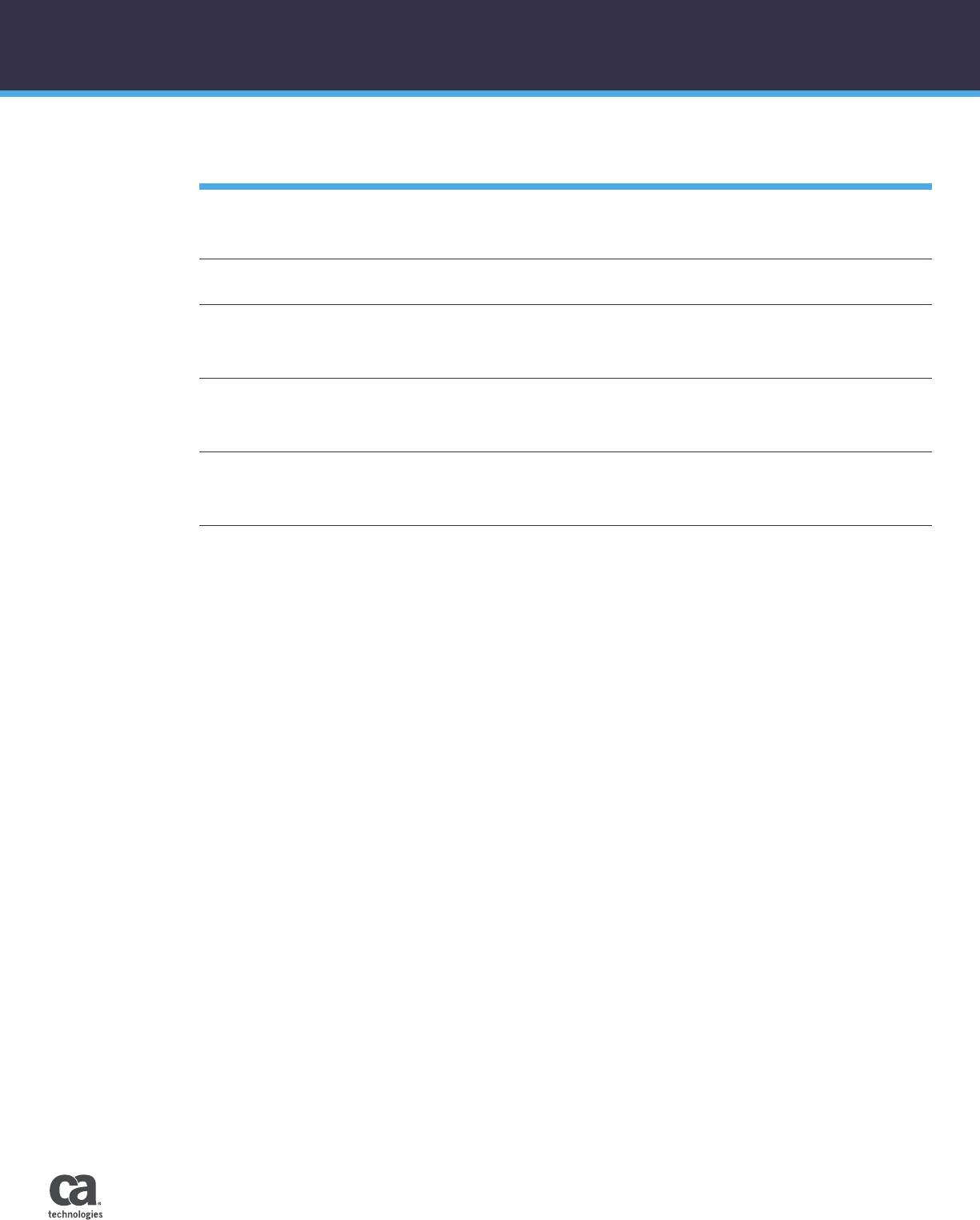
WHITE PAPER • MARCH 2018
The Science Behind Five-Star
Mobile Applications
A guide to leveraging analytics for customer-centric mobile apps
CA App Experience Analytics

Challenge
Building a successful mobile application may seem like performing magic. There are currently more than
5 million mobile apps, and tens of thousands of new ones are released each month. Many fail utterly in
the market, despite the large investments companies make in developing them.
Given the stunning size of the mobile application market, as well as anecdotes about seemingly worthless
apps drawing huge investments, one might conclude that building a successful mobile app requires luck
more than skill and careful planning.
Opportunity
Mobile success is not magic. Mobile developers can and should adopt a systematic, analytical
approach to building mobile applications. Success in the mobile market is not the result of luck, despite
appearances. It is the fruit of careful, deliberate attention to customer needs, and an application
development and management strategy that enables those needs to be met.
Benefits
An analytics-based mobile development strategy is important not only for standing out from the crowd in
a tremendously competitive market, but also for avoiding shortcomings in mobile app delivery that could
harm your business’s image and lead to a loss of customers.
This white paper explains how companies can create five-star mobile apps and avoid making usability,
functionality and performance mistakes in mobile application delivery. It begins by outlining the obstacles
that hamper the development of successful mobile applications, then provides tips and strategies for
implementing an analytical approach to mobile application delivery.
3 • WHITE PAPER • THE SCIENCE BEHIND FIVE-STAR MOBILE APPLICATIONS
Executive Summary
ca.com

SECTION – 1:C
Why Mobile App Development Is Challenging
About 25 percent of the mobile apps the typical user downloads will be used only once. The vast majority
of mobile apps last fewer than 90 days on users’ devices before they are deleted entirely. Two-thirds of
mobile apps fail to achieve more than 1,000 downloads in the first year after their release.
Why is the outlook for mobile app success among consumers so dim? It’s not for lack of investment.
Companies typically spend around $200,000 or more developing a mobile app.
The failure of most mobile apps is instead the result of the following challenges, which make it difficult to
design mobile applications in ways that please users.
Providing the Right Services on the Right Platforms
In many cases, mobile apps are developed alongside Web or PC apps that provide similar functionality.
Developers sometimes make the mistake of trying to include all of the same services in each version of the
app. This approach does not always work because it can lead to mobile (and wearable) apps that are too
complex or that have features that are a poor fit for the screen sizes, input methods and other hardware
characteristics of the devices.
In other cases, developers may fail to take full advantage of the hardware features that are offered on
one type of device but not others; for example, a mobile application might be able to leverage the GPS
functionality that is built into most mobile devices in order to provide a better customer experience,
whereas the PC version of the application cannot do this because most PCs lack GPS hardware.
Instead of attempting to shoehorn as much functionality as possible into mobile applications, developers
should carefully plan which features make sense based on the types of devices they are targeting, as well
as the way their users prefer to interact with the devices and software.
Maintaining a Consistent User Experience
Even if developers choose not to offer all of the same features on all of the device platforms they support,
they must nonetheless strive to deliver a consistent user experience across different platforms. Many
customers switch routinely between different types of devices. A poor user experience on just one device
can drive them away from all versions of an application—and lead to negative feedback about how the
mobile version of an application failed to deliver the usability of its PC-based equivalent, for example.
Large Number of Operating System/Browser Combinations
There are tens of thousands of different types of mobile devices, as well as hundreds of different versions
of Web browsers that might run on a mobile phone. To make matters even more complicated, mobile
operating systems and browsers are updated on a constant basis.
Attempting to support all the possible browser and operating system combinations that customers could
potentially use is simply not feasible. Developers must choose to focus on certain types of software
environments to target and ensure that their software runs as expected in those environments.
Choosing the right browsers and operating systems is a challenging task. The most popular software
configurations among one demographic group may be very different from those preferred by another.
Multiple Development Models
There are multiple approaches to developing mobile applications. Some mobile apps run natively on the
device’s operating system. Others are Web apps that are accessed through a browser. In some cases,
mobile apps are hybrid apps that combine both native and Web-based functionality.
Deciding which development model or models to adopt for creating a mobile application is challenging. It
involves evaluating the ways in which your users can best interact with your software, as well as technical
considerations, such as which types of programming languages and libraries developers can use to
implement and maintain the application most effectively.
4 • WHITE PAPER • THE SCIENCE BEHIND FIVE-STAR MOBILE APPLICATIONS
ca.com

Mobile Device Mobility
Mobility is a core feature of mobile devices, but it also creates special challenges for building effective
mobile software. Application designers must deliver a consistent, reliable user experience on devices that
are constantly moving, experience significant fluctuations in network bandwidth and have limited data
storage and energy resources.
This challenge is made greater by the fact that most consumers lack the expertise to determine the root
of performance problems in mobile applications. If a mobile application fails to deliver an excellent user
experience due to a problem such as poor network connectivity, users will be quick to blame the company
that developed the application, even though it has no control over the reliability of the mobile network
they use.
SECTION – 2
An Analytical Approach to Mobile Development
Responding effectively to these challenges requires more than a haphazard approach to mobile
development. Mobile application designers and developers must systematically evaluate what their users
want, how they interact with devices and which types of technical challenges the application must be
designed to handle in order to deliver an excellent user experience.
In other words, mobile developers must take an analytical approach to app development. An analytical
approach can enable an application to receive high ratings from consumers, delight customers, keep users
coming back and help your company to stand out from competitors.
An analytical approach involves the following strategies and practices:
Systematic Understanding of What Users Want
Mobile developers can’t rely on ad hoc user feedback in forums or bug reports to determine what users
want in an application. They must instead collect detailed, systematic data that allows them to determine
which features and functionality users expect.
They can achieve this insight by “peeking over the shoulder” of users with tools that visualize user touch
and gestures within applications, provide video playback of user sessions and so on. This data should be
collected on a continuous basis and made available constantly to developers in order to help plan new
application features and updates based on user behavior.
Understanding of What Users Don’t Want
Determining which features users don’t want in an application is just as important as identifying those
they do. Developers need to be able to trace which features in an application are not frequently used
so they can remove them if users find them unattractive, or improve them in the case that a usability
problem is keeping users away from them. Maintaining functionality that users don’t want leads to bloat,
inefficient use of developers’ time and potential software security risks.
Tracking of Customer Dropoff
Most customers who abandon an app never take the time to tell developers why they left. Even among
those who do leave feedback, the information—which usually takes the form of generic statements such
as “confusing interface” or “slow to load”—is often too ambiguous to provide useful insights to developers.
For this reason, application developers should rely on software tools that allow them to determine exactly
when and why users stop using an app. They must be able to track, on a screen-by-screen basis, what
happens before the application is closed or the user stops interacting. With this insight, developers can
target particular aspects of the app for improvement.
5 • WHITE PAPER • THE SCIENCE BEHIND FIVE-STAR MOBILE APPLICATIONS
ca.com

Detailed App Debugging Information
When a mobile application crashes or underperforms, developers need detailed, context-aware data
about why the problem occurred. They need to know not just which parts of the application code were
associated with the crash, but also how environment factors such as the user’s location, network carrier
and device hardware profile may have contributed to the problem.
This allows developers to get to the root of performance problems quickly and ensure that certain groups
of users are not saddled with performance issues resulting from environment factors that an application
can’t control.
Omnichannel Visibility
In order to deliver a consistent user experience across all platforms, developers require an omnichannel
view of the user journey. In other words, they need to know when and why users switch from one type of
device (such as a smart watch) to another (such as a phone or PC). By analyzing this data, developers
can determine whether certain versions of their software are underperforming, as well as which types of
platforms to prioritize based on frequency of use.
Understanding of Device Software Configurations
As noted above, there are a vast number of operating system and browser combinations that users
might run on their devices. Rather than attempting to support all possible combinations, which is highly
unfeasible, or choosing the most popular overall configurations, development teams should determine
which software environments are most popular among their target users.
To understand why this decision is so important, consider how Apple iPhone mobile device usage varies
between different groups. The market share of the iPhone in the United States is around 33 percent, but
it is only 2 percent in India. iPhone use also varies significantly between genders, with women being more
likely than men to use an iPhone.
Because the types of devices consumers use can vary widely, developers should be able to collect and
analyze data that shows which devices consumers are using to access their services, as well as how
service performance varies between different types of devices.
Continuous Feedback
We live in a DevOps-dominated world. Most organizations strive to deliver software to users on a
continuous basis. In order to ensure that continuous delivery chains do not outpace the ability of
developers to keep up with user expectations, user feedback must be collected and shared with the
development team on a continuous basis.
The importance of continuous feedback can be easy to overlook. The DevOps movement has tended to
prioritize delivery speed, affording less attention to software quality and performance. Delivery speed is
one factor in providing an excellent user experience, but it is not the only one. Continuous feedback is an
equally important component of a healthy continuous delivery chain—and one that plays an important
role in delivering a quality user experience.
6 • WHITE PAPER • THE SCIENCE BEHIND FIVE-STAR MOBILE APPLICATIONS
ca.com
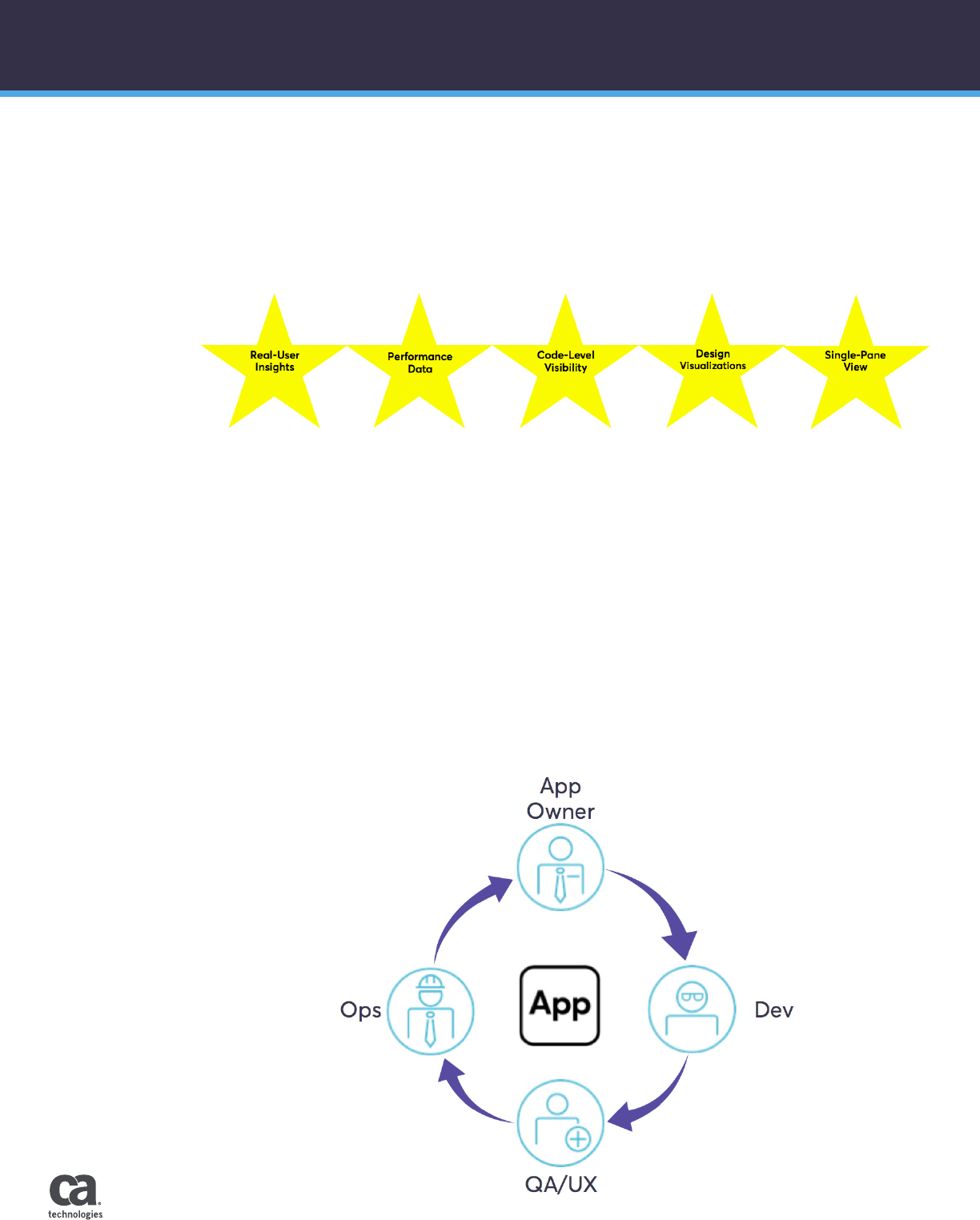
7 • WHITE PAPER • THE SCIENCE BEHIND FIVE-STAR MOBILE APPLICATIONS
ca.com
SECTION – 3
Streamlining Mobile App Analytics
Identifying the right analytics tool
When implementing the strategies described above, mobile app development teams should look for tools
with the following capabilities:
• Real-User Insights: Collect data about application usage, in a granular fashion, in order to reveal how
users interact with particular features in an application and how usage patterns vary between different
devices and demographic groups.
• Performance Data: View end-to-end performance of mobile and wearable apps all the way to back-end
systems—including mainframe and the cloud—to address incidents before they impact your user experience.
• Code-Level Visibility: Allow developers to identify root causes quickly. Developers should be able to
determine whether an app performance problem was the result of poor code, poor design, infrastructure
failures or something else.
• Design Visualizations: Gain insights into application design and flow through analytics visualizations
that aggregate touch and gesture data. These insights will help you understand how users are engaging
with your application and optimize the app’s design and navigation.
• Single-Pane-of-Glass View: Provide a single pane of glass for analyzing application user experience and
performance issues.
FIGURE A.
A single-pane-of-
glass view facilitates
easy interpretation
of data and
enables efficient
communication
between teams—a
particularly
important
consideration in
a DevOps-focused
organization.
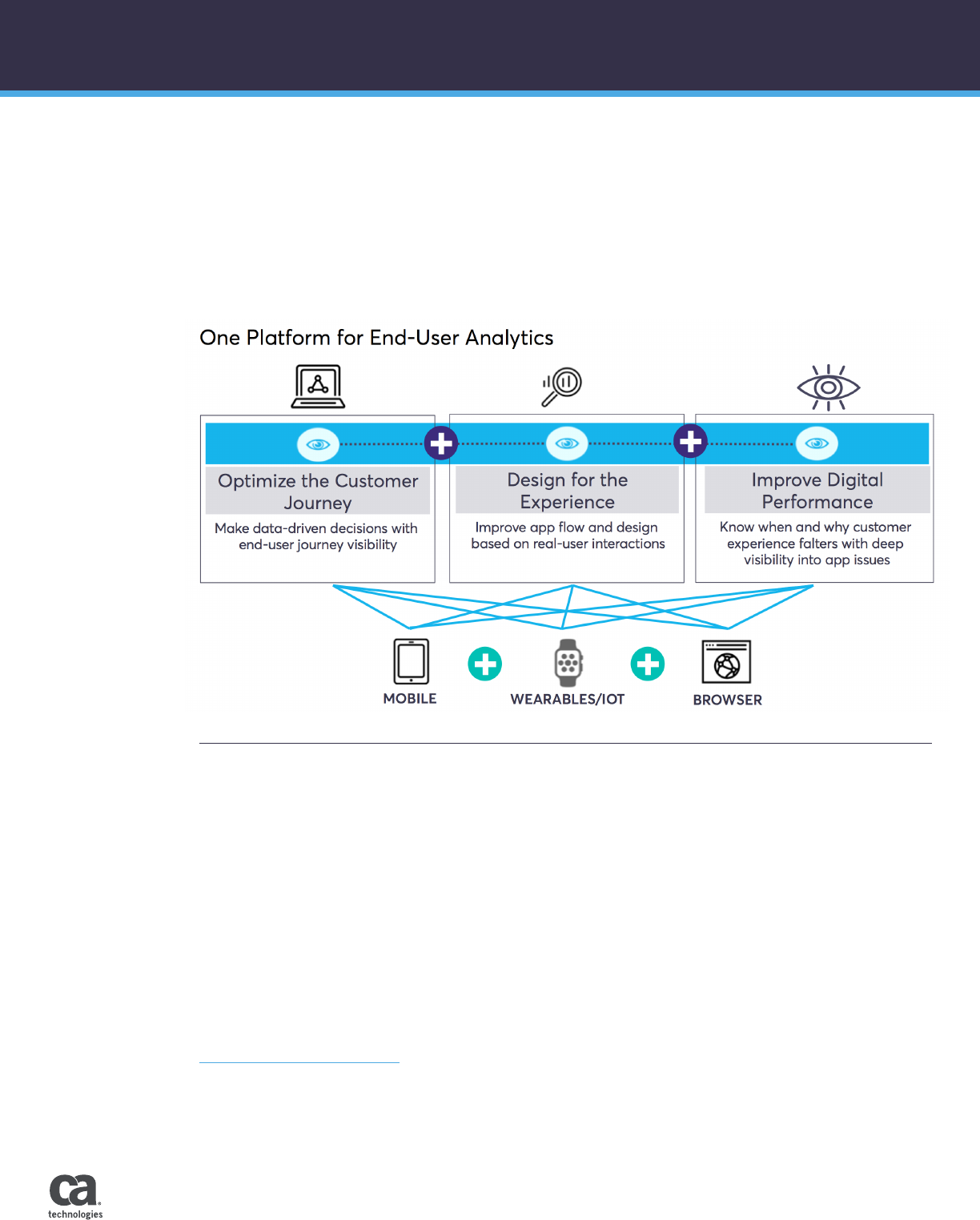
8 • WHITE PAPER • THE SCIENCE BEHIND FIVE-STAR MOBILE APPLICATIONS
ca.com
These features ensure a streamlined process for turning analytics data into usable insights when designing
and improving mobile applications that earn five-star reviews. Choosing an analytics solution with these
key features will enable you to:
• Optimize the customer journey
• Design for the experience
• Improve digital performance
SECTION 4:
Conclusions
Developing mobile applications that stand out from the huge crowds that populate app stores requires
prioritizing the customer experience. To keep customers happy, mobile app delivery teams must adopt a
careful, analytical approach to the features they implement, the devices they support and the way they
leverage feedback about user preferences and behavior.
This strategy is the only reliable means of achieving consistent five-star reviews. Without an analytical
approach to mobile app development, your company’s investment in mobile software is likely to result
only in underused applications and lukewarm user feedback.
An analytical approach to mobile development becomes possible when software delivery teams adopt
tools that provide detailed data about user behavior and preferences and make the data available via
intuitive, efficient interfaces.
CA App Experience Analytics provides the insights you need to deliver a five-star app experience for your
users, enabling you to:
• Optimize the customer journey and make data-driven decisions
• Design for the experience with analytics and visualizations to improve app flow and design based on
real-user interactions
• Improve digital performance and provide the insights to know when and why customer experience
falters with deep visibility into mobile app issues.
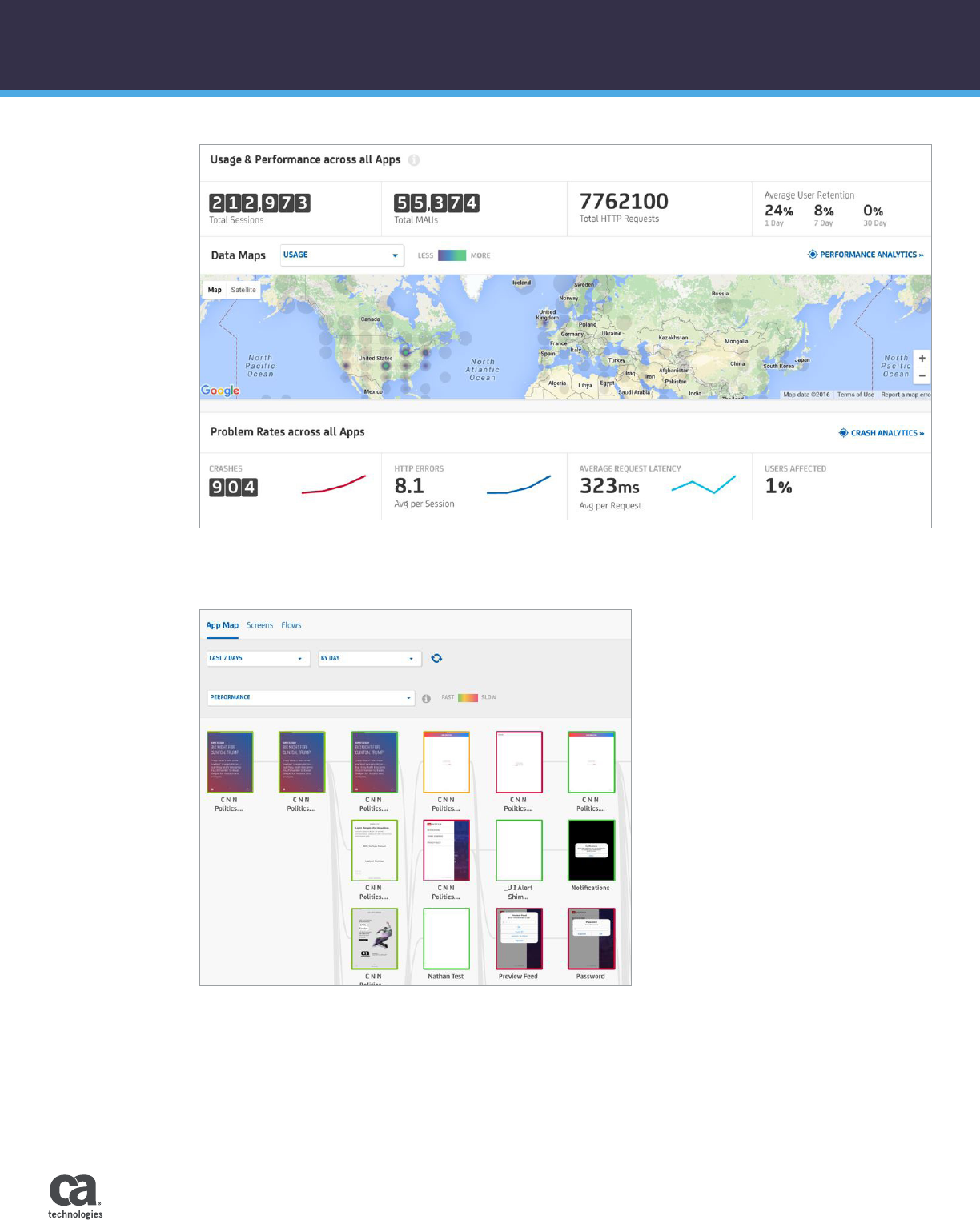
9 • WHITE PAPER • THE SCIENCE BEHIND FIVE-STAR MOBILE APPLICATIONS
ca.com
FIGURE C.
App flows provide
detailed insight
into how customers
are navigating
through your app
and displays app
issues and drop-off
rates by screen.
FIGURE B.
The overview
screen provides an
at-a-glance view of
application usage,
performance,
and crashes and
errors, so you can
quickly evaluate
your customers’
experience and
drill-down into
application issues.
“ CA App Experience
Analytics definitely
has a more advanced
visualization than anything
we’ve used before, and
it’s easier to get an
understanding of what
the data means.”
Chris Kilroy,
Director of Client Integration
and Activation, CNN
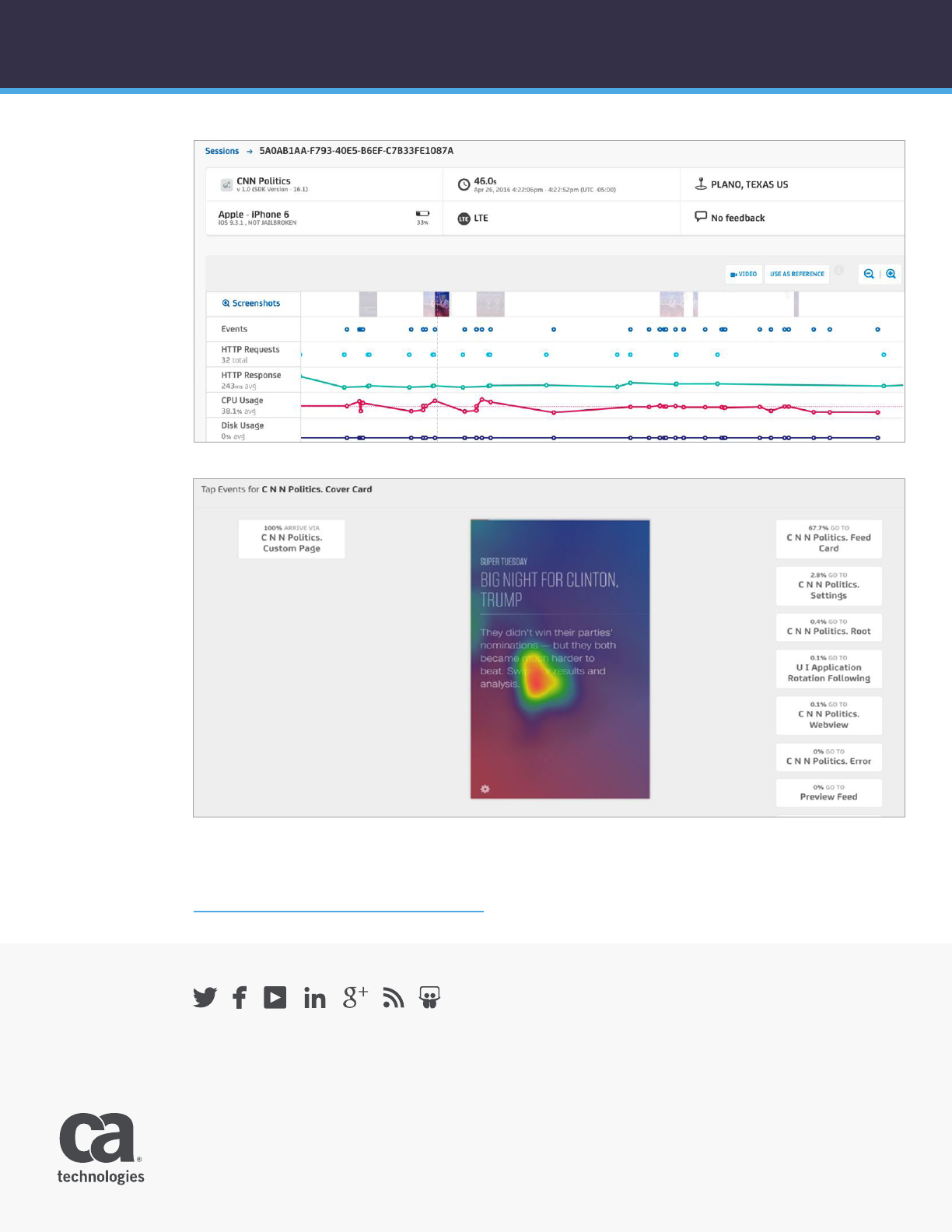
10 • WHITE PAPER • THE SCIENCE BEHIND FIVE-STAR MOBILE APPLICATIONS
ca.com
Connect with CA Technologies
CA Technologies (NASDAQ: CA) creates software that fuels transformation for companies and enables them to seize the
opportunities of the application economy. Software is at the heart of every business, in every industry. From planning to
development to management and security, CA is working with companies worldwide to change the way we live, transact
and communicate—across mobile, private and public cloud, distributed and mainframe environments.
Learn more at ca.com.
Copyright © 2018 CA. All rights reserved. Apple and iPhone are trademarks of Apple Inc., registered in the U.S. and other countries. All trademarks,
trade names, service marks and logos referenced herein belong to their respective companies. This document is for your informational purposes only.
To the extent permitted by applicable law, CA provides this document “As Is” without warranty of any kind, including, without limitation, any implied
warranties of merchantability or fitness for a particular purpose, or non-infringement. In no event will CA be liable for any loss or damage, direct or
indirect, from the use of this document including, without limitation, lost profits, business interruption, goodwill or lost data, even if CA is expressly
advised of such damages. 200-341451_0218
FIGURE D.
App session views
allow you to view
individual sessions
and watch video
session playback
with animated
touch and gesture
visualizations
so you can
understand exactly
what your user
experienced as
they navigated
through your
mobile app.
FIGURE E.
App screen drill-
downs provide
touch and gesture
visualizations so
you can optimize
app design based
on real-user
interactions.
Try CA App Experience Analytics today by
signing up for a free trial.
